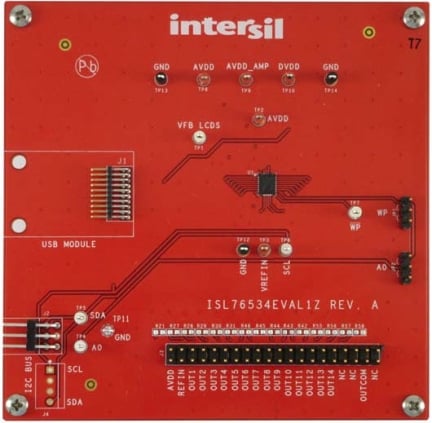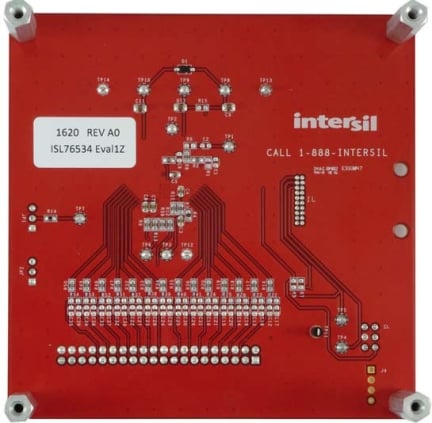概要
説明
The ISL76534EVAL1Z evaluation board is a complete platform used to evaluate the specifications and functionalities of the ISL76534 programmable gamma buffer. The ISL76534 contains an I2C programmable, 10-bit, 14-channel gamma reference voltage generator with buffered outputs, a 10-bit programmable VCOM calibrator, a high output current VCOM amplifier, and an internal EEPROM to store all reference voltage data. The EEPROM features an endurance of 10,000 write cycles and a data retention of 20 years at 105°C.
The ISL76534EVAL1Z board is intended to provide an evaluation platform for the 4mm x 5mm X2QFN ISL76534 package, programmable gamma buffer.
特長
- 15-channel reference voltage outputs, I2C programmable:
- 14-channel gamma references, 10-bit resolution with buffered outputs
- 1-channel VCOM calibrator with 10-bit resolution
- High output current VCOM amplifier
- Ultra-low power operation, ideal for tablet and mobile applications: typical quiescent power, 12mW at 8V AVDD
- EEPROM data retention: 20yrs at 105°C
- EEPROM endurance: 10,000 write cycles
- Read/Write capable over 2.25V to 3.6V DVDD range
- 6.3V to 19V analog supply operating range
- 2.25V to 3.6V digital supply operating range
- 28 Ld 4mm x 5mm super thin X2QFN package
- Pb-free (RoHS compliant)
- AEC-Q100 qualified
アプリケーション
- Automotive infotainment display
- Automotive Center Information Display (CID)
- Automotive smart mirrors
- Automotive instrument cluster display
- Automotive TFT-LCD display
設計・開発
製品選択
適用されたフィルター
ビデオ&トレーニング
Introducing the ISL76534, a programmable gamma buffer for automotive displays. It offers the lowest power consumption and highest reliability in gamma calibration for TFT-LCD displays, ensuring consistent brightness and color matching across all vehicle displays.
Transcript
ISL76534
14-Channel Programmable Gamma Buffer with Integrated EEPROM
I would like to introduce the ISL76534 programmable gamma buffer.
Introducing the ISL76534 14-Ch Programmable Gamma Buffer
The ISL76534 is a 14-channel programmable gamma buffer for automotive displays. It delivers the lowest power and highest reliability gamma calibration for TFT-LCD displays in order to ensure consistent brightness and color matching of all of the displays inside the vehicle.
Two trends in automotive are driving the adoption of programmable gamma calibration. First is the proliferation of displays within a vehicle. Second is the integration of displays into the safety equipment.
Today, more and more vehicle models include displays in the instrument cluster, the center console, the rear-view mirror, and for rear-seat entertainment. Manufacturers go to great lengths to create styling and branding for each model and the styling extends from the exterior of the vehicle in the body and lighting to the interior passenger cabin. Increasingly, it is important that each display has the desired look and matches the others that may be nearby or directly adjacent.
And as displays become critical in relaying important safety information to the driver, such as the backup camera image, ensuring the displays are highly reliable and presents this information accurately is a must.
The ISL76534 is designed to allow vehicle manufacturers to tune each display before it is installed in a vehicle in a highly reliable way without adding significant cost or design complexity.
ISL76534 – 14-Channel Programmable Gamma Buffer
The ISL76534 offers 14 programmable gamma references and 1 programmable VCOM reference. There is integrated non-volatile memory that stores the gamma and VCOM coefficients and an I2C interface is used to program the device.
The gamma references are generated by 10-bit DACs. Each DAC output is buffered with a 60mA output buffer that can swing rail-to-rail.
The VCOM reference is generated by a 10-bit DAC as well. The VCOM DAC is followed by an output amplifier capable of delivering 100mA continuous or 500mA peak current. The inverting input of the amplifier is made available so the VCOM output can be configured as a simple buffer or can utilize feedback from the LCD panel.
The non-volatile memory has been qualified for 10 thousand write cycles and its retention is qualified for 20 years at 105 °C, making it the highest reliability of any automotive grade programmable gamma buffer available today.
The internal power consumption is typically only 12mW (a few mA), so simple linear regulators from the vehicle battery could be used for both the analog and digital supplies, depending on the desired voltage levels.
The ISL76534 is offered in a 28Ld super thin QFN package and is qualified to AEC-Q100 for Grade 2.
Simplified LCD TFT with Gamma Adjustment
This is an example of how a programmable gamma buffer is used in an LCD display. The gamma buffer creates the references for the column driver in the LCD panel. It also creates the reference for the common rail, VCOM. By adjusting the gamma curve, the panel vendor can adjust the way the perceived luminance varies for each color. This has the effect of changing the gray scale and determining a great deal about how our eyes perceive the image.
Examples of Gamma Correction
This is an example of how an image may look with a gamma curve that has not been adjusted properly. The image on the left is the desired or normal image. In the upper image on the right, a low gamma value has been applied. In this case, the bright sections can appear washed out, but the dark sections offer more visible detail. In the lower image, the gamma value has been increased. This has the effect of improving the contrast, but the darker areas lose much of their detail. You can imagine that if you were using this image while backing up your vehicle, you might be concerned that you cannot make out what is potentially obscured in the shadowed or dark areas.
Why Programmable Gamma
There are two primary drivers for using a programmable gamma buffer for in-vehicle displays.
First, manufacturers are interested in making sure the displays look exactly as they’ve intended. This is important as the appearance of a vehicle, both inside and out, has a large impact on the perceived quality and appeal of the automobile. And as displays become more and more prevalent, the chance of them being side-by-side becomes quite possible. Small differences in image appearance can be easily discerned. This is undesirable. Each display coming off the manufacturing line should look just like the demo model used when the designers are customizing the vehicle.
The second factor that leads vehicle manufacturers to require displays with finely tuned gamma is safety. Safety increasingly sells cars. It is unacceptable and potentially opens up the manufacturer to additional liability if the image quality is poor. In the lower image where the scene is dark, we can barely see the neighboring vehicle and almost nothing which is directly behind us. It is important that the display is clear and reliable to improve the safety of the vehicle.
Monotonic Startup of Gamma Outputs, Power Sequence Free
An important quality of a programmable gamma buffer is how the outputs behave at startup. If the gamma outputs come up and cross each other or are non-monotonic, this can cause the column buffer IC to latch-up and cause the display to be blank or frozen. When I say ‘cross each other’, what I mean is that if output 14 is programmed to a higher output voltage than output 13, then during the startup ramp of the outputs, output 14 should always be higher in voltage than output 13. When I use the word ‘monotonic’, I mean that the outputs should be only increasing –the sign of their slope should never change.
The ISL76534 requires no power supply sequencing and its outputs come up in a monotonic fashion. In the upper figures, we show the way the outputs ramp up on two time scales. There is an initial fast ramp up followed by a slower settling to the desired output value. In no case do the output voltages reverse on themselves or cross their neighboring voltages.
In the comparison startup plots, the outputs have a very peculiar pattern while the device reads out the contents of its non-volatile memory. This could be very problematic and lead to reliability issues.
I should also mention that gamma buffers that do not have integrated EEPROMs can also create startup problems while a local memory is being accessed and the values are being programmed into the buffer.
So, the ISL76534’s combination of integrated NVM and well controlled startup are critical to ensuring the reliability of the display. This is a very important factor, especially with backup cameras where in the US, the display has to be guaranteed to be able to present the backup image in under two seconds. A frozen or blank display adds unacceptable risk.
Target Applications
The target applications for the ISL76534 are automotive displays. The most common use cases are in the vehicle smart mirrors, where a standard mirror is replaced with a camera and some type of display, the center information display for navigation and control of various vehicle systems, and LCD-based instrument clusters.
Typical Display Block Diagram
There are other associated automotive-grade products that can also be offered. We have two TFT LCD power management ICs, ISL78419 and ISL78010. We also offer the ISL78171, a 6-channel LED backlight driver.
ISL76534 Evaluation Boards – Start Designing Today!
To aid in the design-in process, we provide evaluation boards and associated software for the ISL76534. You can find more information about these on our website.
ISL76534 14-Channel Programmable Gamma Buffer
To summarize, ISL76534 is a 14-channel programmable gamma buffer with integrated EEPROM. It is qualified for automotive use across the ambient temperature range of -40 °C to 105 °C. Without introducing significant cost or complexity, the ISL76534 helps the vehicle designer achieve higher quality, consistency and reliability into the displays. These key capabilities are becoming increasingly important as displays become more popular within the vehicle and become integrated into the vehicles safety mechanisms.
Thank you for your time.


